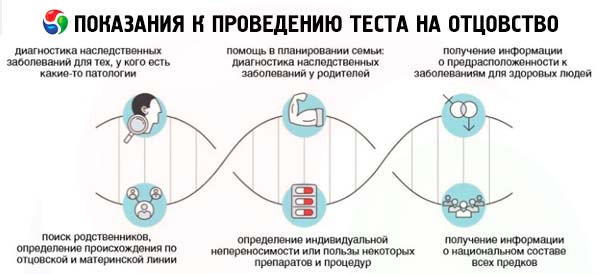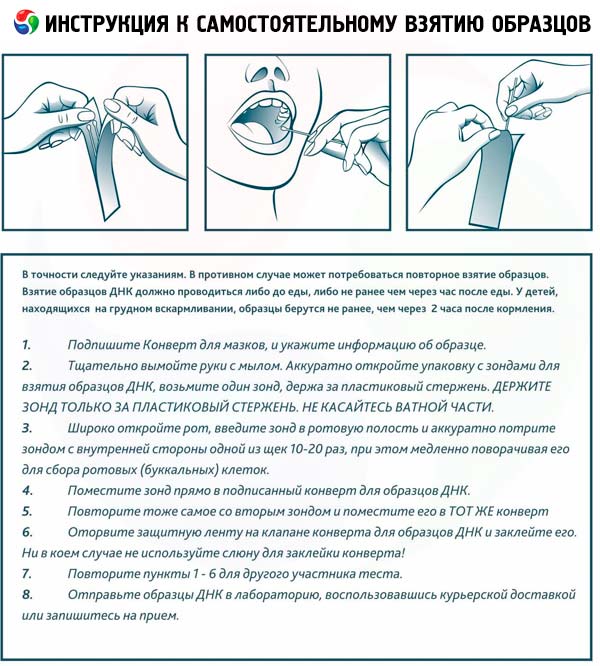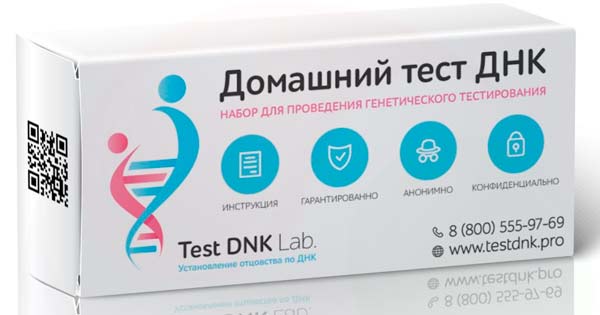DNA test for determining paternity
Last reviewed: 23.04.2024

All iLive content is medically reviewed or fact checked to ensure as much factual accuracy as possible.
We have strict sourcing guidelines and only link to reputable media sites, academic research institutions and, whenever possible, medically peer reviewed studies. Note that the numbers in parentheses ([1], [2], etc.) are clickable links to these studies.
If you feel that any of our content is inaccurate, out-of-date, or otherwise questionable, please select it and press Ctrl + Enter.

From school lessons we remember that a person, like any other living organism, consists of a multitude of cells. At the person of them it is totaled approximately 50 trillion. The nucleus of each cell contains molecules of deoxyribonucleic acid, abbreviated DNA. Their structure in 1953 was opened by British and American scientists, for which they received the Nobel Prize. Molecules are multidimensional, consisting of two long (about one meter) interwoven chains, twisted into a spiral. Between each other, the chains are connected by a kind of crossbeams resembling a ladder. All this "construction" is divided into genes, each of which is responsible for a specific biological function. The double helix contains 26kt. Genes. A complete set of them is called a "genome". The genome of each individual person is unique, this is the program of our life. It contains hereditary codes by which you can determine the relationship of people. In each genome, there are 2 copies of one gene - one from the father, the other from the mother. This makes it possible to conduct a test for paternity.

The DNA test for paternity establishes whether or not a man who is considered the father of a child is one. Statistics say that 90% of these tests are ordered by men. In the study of samples, those long polymer molecules contained in the nucleus of cells taken from two objects are analyzed. By coincidence of loci - the location of a specific gene on the chromosome map and the relative affinity or absence of two people is determined.
 [1]
[1]
Indications for the procedure of the paternity test
Indications for conducting a dna test is the desire to make sure that the child is really from his father (will calm jealous husbands), fear of hereditary pathologies, diagnosis of existing or possible diseases. In recent years, such a test is very much in demand to confirm kinship due to the tragic events in the country related to military operations taking place in the country. It is also used in criminalistics if it is impossible to establish the identity of the victims of crime.

DNA test for paternity for trial
To establish paternity through the court will need to adhere to special procedural rules. For example, the DNA test for paternity in accordance with the Law of Ukraine "On Forensic Examination" is conducted only in state laboratories of the Ministries of Justice, Health and Defense. For the analysis, the blood of the child, the mother and the alleged father are used. The result is not given to parents, but goes to court. The pre-trial DNA test can only motivate the judiciary to assign its own analysis, and in case of the respondent's refusal to undergo an official examination, it will serve as an indirect evidence of his involvement in the appearance of the child.
A paternity test without the consent of the mother
A paternity test without the mother's consent in non-state laboratories is possible and does not even require her consent, but the accuracy of the result with her participation may be higher.
Preparation
After selecting and applying to the laboratory, a person receives a detailed instruction from the laboratory assistant how to assemble the material to be examined, if this procedure is carried out by the applicants themselves, and issues envelopes. Preparation consists in the obligatory following of the received recommendations when taking a genetic sample from each of the participants. For this purpose, hair, nails, blood, saliva, discharge from the nose will do.
 [9]
[9]
Technique of the paternity test
The technique of analyzing the human genome in determining paternity does not require a detailed study of it. For the identity of two compared objects, 14 coincidences of DNA fragments are sufficient. Some laboratories make up to 30 comparisons in order to obtain the most reliable information.

You can obtain material for analysis in two ways: invasive (through penetration into the body) and non-invasive. A non-invasive paternity test involves:
- test for paternity by hair - this non-standard method is used when there is no possibility to take a swab of oral cavity for analysis. For analysis, only hair with a bulb is suitable. A 100% guarantee of success of this procedure is not available, because it may not be possible to extract a DNA profile. Having at least 10 hairs will increase the chances. Touching them with your bare hands is not worth it. It is best to use tweezers or gloves. If they are picked up in the bathroom, then you must first dry them. Then the hairs are folded into a clean paper or plastic bag, a container. Do not use the material after cosmetic fixation or embalming, as well as hair cut with scissors, left on the comb without bulbs. Help in determining paternity earwax, chewing gum, used handkerchief. Another participant in the test can take a standard sample, for example a swab from the mouth;
- test for paternity for saliva - for it you will need, so-called buccal epithelium - a smear from the inside of the cheek. The advantage of this method is in the convenience and simplicity of sampling.

The test for paternity by blood is an invasive method. For this analysis, blood from the vein will be needed. The advantage of it is that you can take enough material to determine the identity of the genome, and the disadvantage is that you need to have a personal presence, for which you often have to travel long distances.
Other invasive methods include the prenatal paternity test.
Prenatal test for paternity during pregnancy
Modern medicine at a level of development that can give an answer even before the birth of the child, who the father is. An antenatal paternity test is performed during pregnancy. There are such methods:
- Chorion biopsy - is used in the first trimester of pregnancy (up to 12 weeks). Biomaterial sampling is carried out with the help of a needle, introduced by a doctor under ultrasound observation, to the envelope covering the fetus. According to statistics, the threat of miscarriage does not exceed 3%;
- amniocentesis - amniotic fluid is taken as a material. The procedure is possible between 14 and 20 weeks of pregnancy. It involves penetrating a thin needle through the peritoneum into the uterus to collect liquid. There is a slight (up to 1%) risk of complications;
- Cordocentesis - blood is taken from the umbilical cord.
Home test for paternity
A paternity test can be done without leaving home. For the special sampling of the material, special packages are sold that include gloves, a brush, a test tube, an instruction, a contract form with the laboratory. Samples should be provided by the father, mother and child. Before taking it, you need not eat, drink, brush your teeth.

After rinsing the mouth with warm water, rub with a brush for one minute on each side on the inside of the cheek and leave for half an hour in the air, then lower into a test tube and close. Put in an envelope and send it by mail or deliver it yourself. How much is the paternity test done? The test result can be received in 3-5 days by mail or call. There is also an express test for paternity, it is ready in 24 hours.
Paternity test results
The accuracy of the paternity test is 99.99-99.9999999% to confirm paternity. Missing up to 100% 0.01% means that theoretically there is a probability of having a potential twin brother with the same genome. A negative test is always 100%.
How to cheat the paternity test?
Is it possible to deceive the paternity test? Licensed laboratories provide guarantees for the reliability of their findings. The study is carried out by two independent groups of experts on two automatic analyzers, after which the results are checked. Thus, the influence of the "human factor" is reduced to a minimum. Cheating can be done at the sampling level for samples at home.
Where can I make a paternity test?
For the paternity test, there are special DNA laboratories equipped with analyzers capable of matching up to several dozen genetic markers. The most famous in Ukraine is Medical Genomics Ukraine LLC, which represents the British laboratory Medical Genomics Ltd. In our country it has been since 2007, it has collection points in 43 cities. In the capital, such an analysis is carried out by the Scientific Medical Center, the clinic of reproductive medicine "Nadia", the medical center "Mother and Child", the laboratory of Dr. Rödger and others.

